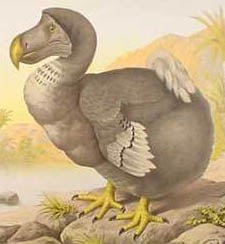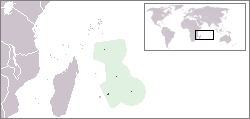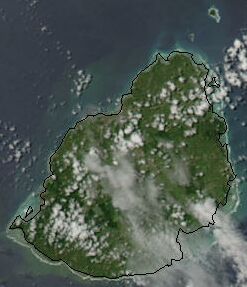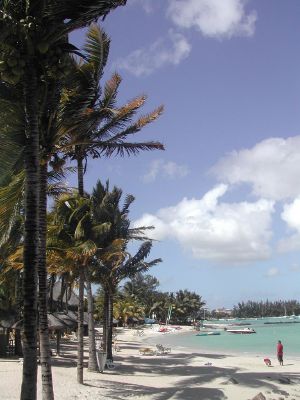Mauritius
| Republik Moris République de Maurice Republic of Mauritius |
||||||
|---|---|---|---|---|---|---|
|
||||||
| Motto: "Stella Clavisque Maris Indici" (Latin) "Star and Key of the Indian Ocean" |
||||||
| Anthem: "Motherland" |
||||||
| Capital | Port Louis | |||||
| Official languages | None (de jure) English French (de facto)[1] |
|||||
| Vernacular | Mauritian Creole French English Rodriguan Creole |
|||||
| Demonym | Mauritian | |||||
| Government | Unitary parliamentary republic | |||||
|  -  | President | Prithvirajsing Roopun | ||||
|  -  | Vice President | Eddy Boissézon | ||||
|  -  | Prime Minister | Navin Ramgoolam | ||||
| Legislature | Parliament | |||||
|  -  | Lower House | National Assembly | ||||
| Independence | from the United Kingdom  | |||||
|  -  | Date | March 12, 1968  | ||||
|  -  | Republic | March 12, 1992  | ||||
| Area | ||||||
|  -  | Total | 2,040 km² (169th) 790 sq mi  |
||||
|  -  | Water (%) | 0.07 | ||||
| Population | ||||||
|  -  | 2019 estimate | 1,270,091[2] (158th) | ||||
|  -  | 2022 census | 1,235,260[3]  | ||||
|  -  | Density | 618.24/km² (21st) 1,602.55/sq mi |
||||
| GDP (PPP) | 2024 estimate | |||||
|  -  | Total | |||||
|  -  | Per capita | |||||
| GDP (nominal) | 2024 estimate | |||||
|  -  | Total | |||||
|  -  | Per capita | |||||
| Gini (2017) | 36.8[5]  | |||||
| Currency | Mauritian rupee (MUR) |
|||||
| Time zone | MUT (UTC+4) | |||||
| Internet TLD | .mu | |||||
| Calling code | +230 | |||||
Mauritius, officially the Republic of Mauritius, is an island nation off the coast of Africa in the southwest Indian Ocean, about 560 miles (900 km) east of Madagascar. Largely populated by Indian and Creole descendants of those brought in to work the sugar plantations, it stands out for its political stability and inter-ethnic harmony. Mauritius, which has the second highest GDP per capita in Africa, aims to become the business hub of the Indian Ocean. New business opportunities in banking and the technology sector are being actively sought.
As with other island nations, it also capitalizes on its beautiful scenery to attract upscale tourists. Though it was once the home of the extinct dodo bird, today Mauritius is working to preserve and restore its indigenous plants and animals, some of them rare.
Geography
In addition to the island of Mauritius, the republic includes the islands of St. Brandon, Rodrigues, and the Agalega Islands. Mauritius is part of the Mascarene Islands, with the French island of Réunion 200 km (125 mi) to the southwest and the island of Rodrigues 570 km to the east-northeast.
This archipelago was formed in a series of undersea volcanic eruptions, as the African plate drifted over the Réunion hotspot. Mauritius and Rodrigues were formed 8-10 million years ago. They are no longer volcanically active. The island of Mauritius itself consists of a broken ring of mountain ranges around a central plateau, with its highest peak in the southwest: Piton de la Petite Rivière Noire at 2,717 ft(828 m). Around the mountains are low-lying, sometimes hilly, coastal plains that cover almost half of the land area. The plateau covers about a quarter of the island and mountains about 18 percent. Rivers and streams are plentiful, many deeply graded as they flow from the tableland to the sea. Marshes and ponds lie in the tableland and the plain.

Rodrigues Island sits lengthwise on an east-west axis and has a spinelike mountain range. The two Agalega islands are formed from coral. They are connected by a sandbar and covered with coconut palms.
The local climate is tropical, with variations depending on the altitude, and is modified by southeast trade winds; there is a warm, dry winter from May to October and a hot, wet, and humid summer from November to May. Rainfall is abundant. Cyclones affect the country from November to April.
The island's capital and largest city is Port Louis, in the northwest. Other important towns are Curepipe, Vacoas, Phoenix, Quatre Bornes, Rose-Hill, and Beau-Bassin.
Flora and fauna
Mauritius is well known for its exceptional natural beauty;
"You gather the idea that Mauritius was made first and then heaven, and that heaven was copied after Mauritius,"
as Mark Twain noted in Following the Equator.
The Black River Gorges hold a nature reserve with a humid sub-tropical primary forest. The Macchabée forest, another reserve, also contains rare species. In the region of the Piton de la Petite Rivière Noire, the highest peak on the island, is the Valriche nature reserve with a wide variety of indigenous, medicinal, and fruit trees. Fauna dwelling there include deer, wild boars, monkeys, bats, and rare bird species such as the grosse cateau vert and the paille en queue.
About 20 small islands surround Mauritius. Some of them, such as l'Ile Ronde and l'Ile aux Aigrettes, have been proclaimed natural reserves and are home to several rare bird species such as the paille-en-queue, the fouquet, and the kestrel. On Ile aux Aigrettes are the remnants of a coastal forest where the dodo, long since extinct, sought shelter. It is still home to a large number of plants and animal species that are unique to Mauritius but threatened with extinction. The Mauritian Wildlife Foundation has cleared, replanted, and restored 90 percent of this islet. It has reintroduced indigenous plants, birds, and reptiles, such as giant tortoises.
Fish abound in the coral reefs around the island, particularly the northern part, such as morays, clown-fish, and golden perch, as well as a variety of sharks, including the blacktail shark, the reef shark, and the black tip reef shark.
History
The first record of Mauritius comes from Arab and Malay sailors as early as the tenth century. Portuguese sailors first visited it in 1505 and established a visiting base, leaving the island uninhabited. Three ships of the eight in a Dutch fleet that was en route to the Spice Islands were blown off course during a cyclone and landed on the island in 1598. The Dutch named it in honor of Prince Maurice of Nassau, the stadtholder (head of state) of the Netherlands.[6] In 1638, the Dutch established the first of two settlements. Because of tough climatic conditions, including cyclones, and the deterioration of the settlement, they abandoned the island by 1710, leaving as a legacy the extinction of the dodo bird, ravaged ebony forests, and the introduction of sugarcane.
The French, who controlled the neighboring islands of Rodrigues and Réunion), seized Mauritius in 1715 and in 1722 established a settlement they named Ile de France (Isle of France). Under the French, the population increased and the economy, based on sugar, prospered through slave labor. Port Louis became a major shipping center. The French, however, harbored the mercenary pirates who preyed on British vessels laden with gold, precious gems, silk, and spices on their way to Britain from India. The British set out to gain military control of the island. Despite winning the famous Battle of Grand Port, Napoleon's only naval win over the British, the French were defeated by the British in the north of the island, at Cap Malheureux (Hapless Cape) three months later, and thus lost possession to the British in 1810. The 1814 Treaty of Paris formally awarded the island, with others, to Britain, but French remained the dominant culture as the plantation-owning Mauritians of French origin retained their holdings and influence. Slavery was abolished in 1835.
Mauritius became Britain's main sugar-producing colony, growing almost 10 percent of the world's sugarcane by the mid nineteenth century, though that role declined as other countries increased their production. Indentured workers were brought from India to replace the slaves as cheap labor. By 1871, more than two-thirds of the population was Indian.
In the twentieth century, movements to improve labor laws and introduce political reforms began to be organized, a process that accelerated after World War II. A constitutional conference held in London in 1965 decided the island should become independent. One price would be to split the Chagos Archipelago from Mauritius to create the British Indian Ocean Territory, so Britain could use the strategic islands for defense purposes in cooperation with the United States. Although the government of Mauritius agreed to the move at the time, subsequent administrations have laid claim to the islands, stating that the divestment was illegal under international law - a claim recognized by the United Nations. Mauritius attained independence in 1968 and the country became a republic within the Commonwealth in 1992.
Mauritius has been a stable democracy with regular free elections and a positive human rights record, and has attracted considerable foreign investment. It has one of Africa's highest per capita incomes.
Politics
Mauritius is a parliamentary democracy based on the British model. The head of state of Mauritius is the president, who is elected for a five-year term by the National Assembly, the unicameral Mauritian parliament. The National Assembly consists of 62 members elected directly by popular vote, with between 4 and 8 further members appointed from among the "best losers" of the candidates to represent ethnic minorities, if underrepresented after the elections. The government is headed by the prime minister and a council of ministers.
Historically, elections have always had a tendency to adhere to a system comprising two major coalitions of parties.
Mauritian law is an amalgam of French and British legal traditions. The Supreme Court‚ÄĒa chief justice and five other judges‚ÄĒis the highest judicial authority. There is an additional right of appeal to the Queen's Privy Council. Local government has nine administrative divisions, with municipal and town councils in urban areas and district and village councils in rural areas. The island of Rodrigues forms the country's tenth administrative division.
Foreign affairs
Mauritius has particularly strong relations with Britain, France, India, and South Africa. It is part of the African Union, the Indian Ocean Commission, the Southern African Development Community, the Commonwealth of Nations, and La Francophonie (French-speaking countries), among others. Both Britain and France are important sources of aid, as well as is India.
Considered part of Africa geographically, Mauritius has friendly relations with other African states in the region. Mauritian investors are gradually entering African markets, notably Madagascar and Mozambique. Mauritius coordinates much of its foreign policy with the Southern Africa Development Community and the African Union.
Military
Mauritius does not have a standing army. All military, police, and security functions are carried out by 10,000 active-duty personnel under the command of the Commissioner of Police. The 8,000-member National Police is responsible for domestic law enforcement. The 1,400-member Special Mobile Force (SMF) and the 688-member National Coast Guard are the only two paramilitary units in Mauritius. Both units are composed of police officers on lengthy rotations to those services.
The SMF is organized as a ground infantry unit and engages extensively in civic works projects. The Coast Guard has four patrol craft for search-and-rescue missions and surveillance of territorial waters. A 100-member police helicopter squadron assists in search-and-rescue operations. There also is a special supporting unit of 270 members trained in riot control.
Districts and dependencies
The island of Mauritius itself is divided into nine districts:
Dependencies of Mauritius:
- Rodrigues, an island northeast of Mauritius that attained limited autonomy in October 2002.[7]
- Agalega, two small islands about 580 mi (933 km) north of Mauritius.
- Cargados Carajos Shoals, also known as the Saint Brandon islands, about 250 mi (402 km) north of Mauritius.
Other Mauritian territories:
- Soudan Banks (including East Soudan Bank)
- Nazareth Bank
- Saya de Malha Bank
- Hawkins Bank
Mauritius also claims the following islands:
- In French possession: Tromelin Island, Île Saint-Paul, Île Amsterdam
- In Seychellois possession: √éle Platte and Co√ętivy Island
- In British possession: Chagos Archipelago
Economy
Since independence in 1968, Mauritius has developed from a low-income, agriculturally based economy to a middle income diversified economy with growing industrial, financial, and tourist sectors. For most of the period, annual growth has been around 5-6 percent. This has been reflected in increased life expectancy, lowered infant mortality, and a much improved infrastructure.
Mauritius has the second highest GDP per capita in Africa, only exceeded by Equatorial Guinea, which derives most of its revenue from oil exports. Mauritius has a mature economy with a great deal of wealth distribution among its citizens. The economy is mainly dependent on sugarcane plantations, tourism, textiles, and financial services. In recent years, information and communication technology (ICT) and seafood have emerged as important sectors of the economy. However, since 2002, the economy started to face some serious challenges as a result of globalization, involving the erosion of trade preferences for both textiles and sugar, two pillars of the economy. Economic growth declined while unemployment, the budget deficit, and public debt increased steadily.
The government that took office in July 2005 embarked on a bold economic reform program aimed at moving Mauritius from reliance on trade preferences to global competitiveness. The reform strategy was designed not only to remedy fiscal weaknesses but also to open up the economy, facilitate business, improve the investment climate, and mobilize foreign direct investment and expertise.
In addition to encouraging the restructuring and modernization of the textile and sugar sectors, the government put much emphasis on the development of the ICT sector and the promotion of Mauritius as a regional seafood hub. To further diversify the economic base and generate sustainable growth, the government is actively encouraging the following economic activities: (a) the land-based oceanic industry, (b) hospitality and property development, (c) the health care and biomedical industry, (d) agro-processing and biotechnology, and (e) the knowledge industry.
Mauritius has a long tradition of private entrepreneurship, which has led to a strong and dynamic private sector with a well-developed legal and commercial infrastructure. It also has a well-developed digital infrastructure and offers state-of-the-art telecommunications facilities. The government's policy is to facilitate business, leaving production to the private sector. However, it still controls key utility services directly or through parastatals, including electricity, water, waste water, postal services, and broadcasting. The State Trading Corporation controls imports of rice, flour, petroleum products, and cement.
The government's development strategy centers on foreign investment. Mauritius has attracted more than nine thousand offshore entities, many aimed at commerce in India and South Africa. Investment in the banking sector alone has reached over $1 billion. France is the country's biggest trading partner and provides technical assistance in various forms.
Mauritius is gearing toward becoming a duty-free island. Duty has been decreased (and for many products completely eliminated) for more than 1,850 products, including clothing, food, jewelry, photographic equipment, audio-visual equipment, and lighting equipment.
The main motivations are to (1) attract more tourists instead of going to Singapore and Dubai, and, (2) give all Mauritians easier access to quality products at affordable prices.
Agriculture includes sugar, sugar derivatives, tea, tobacco, vegetables, fruits, flowers, and fishing. Manufacturing focuses on labor-intensive goods for export, including textiles and clothing, watches and clocks, jewelry, optical goods, toys and games, and cut flowers.
Major markets are Europe and the United States. It imports meat, dairy products, fish, wheat, rice, wheat flour, vegetable oil, petroleum products, iron and steel, cement, fertilizers, machinery and transport equipment, and textile industry raw materials. The major suppliers are South Africa, France, China, India, Bahrain, Finland, United Kingdom, Japan, Australia, and Germany.
Demographics
Mauritian society is highly multi-ethnic. Although tensions exist, in general "harmonious separatism" prevails. Most of the island's residents are the descendants of people from the Indian subcontinent. Mauritius also has large immigrant populations from continental Africa, Madagascar, France, Great Britain, and China, among other places.
Language
The official language is English, the language of all government documents. French is also used in the educational system. French, however, predominates in the media, both broadcast and printed, as well as in business. Mauritian Creole, which is derived from French with influences from the other dialects, is widely spoken and is considered the native tongue of the country. Creole was the language used by the African slaves to communicate with their French masters. Today, Creole is used in everyday life by all Mauritians. Hindi is also widely spoken, though restricted to the Indian community. Several other languages, including Arabic, Urdu, Tamil, Telugu, Marathi, Bhojpuri, Gujarati, Punjabi, and dialects of Chinese, such as Cantonese, Hakka, and Mandarin, are also spoken.
Small groups of foreign students from Europe or the Indian Ocean region are also present. The recent years have seen a steady flow of foreign workers, mostly Chinese women, into the textile industry, Indian workers in the construction industry, and Taiwanese men in harbor-related activities. Immigration policy does not provoke much debate in Mauritius, and the relative economic stability of the island is attracting more foreign workers.
Religion
An officially secular state, Mauritius is a religiously diverse nation, with freedom of religion being enshrined as a constitutional right. The culture of the Mauritian people is reflected in the various religious festivities that are celebrated throughout the year, some of which are recognized as public holidays.
Around 50 percent of the Mauritian population follows Hinduism, mostly Biharis with Tamil, Telugu, and Marathi minorities. Other religious affiliations include Christianity and Islam.
Education
Education has been free through the secondary level since 1976 and through the postsecondary level since 1988. The principal institution of higher learning is the University of Mauritius. English is the main language of instruction, but French is also required. Nearly 85 percent of the adult population is literate.
Culture
Cuisine
The cuisine of Mauritius is a blend of Indian cuisine, Creole, Chinese, and European. It is not uncommon for a combination of cuisines to form part of the same meal. The "cari poule" or chicken curry, for example, is a very popular dish. The "mine-frit" (Chinese fried noodles) and "niouk nien" (dumplings) are loved by all and readily bought by the Mauritian community either in restaurants or on the sidewalks of main streets. 'Alouda' (a milk-based drink with basil seeds) has become a typical Mauritian drink, and the 'dholl puri' can be considered a favorite with all communities.
Rum trade
The historical evolution of the rum industry in Mauritius is no less enriching than that of the Caribbean or that of South America.
Sugarcane was first introduced on the island when the Dutch colonized it in 1638. Even then, the propensity of making rum out of sugarcane was strongly recognized. Sugarcane was mainly cultivated for the production of ‚Äúarrack,‚ÄĚ a precursor to rum. Only much later, almost 60 years after, was the first proper sugar produced. However, it was during the French and English administration that sugar production was fully exploited. This highly contributed to the economic development of the island. It was Pierre Charles Fran√ßois Harel who initially proposed the concept of local distillation of rum in Mauritius, in 1850. In part due to his efforts, Mauritius today houses three distilleries and is opening another three.
Music
The sega is the local folklore music. Sega has African roots, and the music is produced using goat-skin percussion instruments called ravane and metallic clicks using metal triangles. The song usually describes the miseries of slavery and has been adapted nowadays as social satires to voice inequalities felt by the blacks. The rhythm, however, remains very festive and while the men are at the instruments, the Creole women gyrate in large fluid and revealing skirts with bright colors. Shows are regularly hosted in the coastal hotels.
In 1847, Mauritius became the fifth country in the world to issue postage stamps. The two types of stamps issued then, known as the Red Penny and the Blue Penny are probably the most famous stamps in the world, being very rare and therefore also very expensive. When discovered, the island of Mauritius was home to a previously unknown species of bird, which the Portuguese named the dodo (simpleton), as they appeared not too bright. However, by 1681, all dodos had been killed by settlers or their domesticated animals. An alternate theory suggests that the imported wild boar destroyed the slow-breeding dodo population. Nevertheless, the dodo is prominently featured as a supporter of the national coat-of-arms (see image above).
Horse racing (April-December) is one of the most popular sports on the island and the electrifying ambiance at Port Louis (Champ de Mars), notably for the Maiden Cup (listed race), is unique in world racing.
The island has also given rise to a diversified literature, prominent in French, English, Creole, and Hindi languages.
Notes
- ‚ÜĎ The Mauritian constitution makes no mention of an official language. The Constitution only mentions that the official language of the National Assembly is English; however, any member can also address the chair in French.
- ‚ÜĎ Mauritius Population Worldometer. Retrieved November 14, 2024.
- ‚ÜĎ 2022 Population Census ‚Äď Main Results Statistics Mauritius. Retrieved November 14, 2024.
- ‚ÜĎ 4.0 4.1 4.2 4.3 World Economic Outlook Database, October 2023 Edition. (Mauritius) International Monetary Fund. Retrieved November 14, 2024.
- ‚ÜĎ GINI index (World Bank estimate) ‚Äď Mauritius World Bank. Retrieved November 14, 2024.
- ‚ÜĎ T. D. Mutch, The First Discovery of Australia With an account of the Voyage of the "Duyfken" and the Career of Captain Willem Jansz. (Sydney: 1942). Retrieved November 14, 2024.
- ‚ÜĎ Rodrigues Regional Assembly FAQs Republic of Mauritius Portal. Retrieved November 14, 2024.
ReferencesISBN links support NWE through referral fees
- Carter, Marina, and Khal Torabully. Coolitude: an anthology of the Indian labour diaspora. Anthem South Asian studies. London: Anthem, 2002. ISBN 1843310031
- Cutter, Charles Hickman. Africa, 2006. World today series. Harpers Ferry, WV: Stryker-Post Publications, 2006. ISBN 1887985727
- Dodd, Jan, Madeleine Philippe. Lonely Planet Mauritius Reunion & Seychelles. Lonely Planet, 2004. ISBN 9781740593014
- Lee, Jacques K. Mauritius Its Creole Language - the Ultimate Creole Phrase Book and Dictionary. Gardners Books, 2005. ISBN 9780951129647
- Lee, Jacques K. Sega: the Mauritian folk dance. London: Nautilus, 1990. ISBN 0951129619
- Metz, Helen Chapin (ed.). Indian Ocean: Five island Countries.Library of Congress, 1996. ISBN 0844408573
External links
All links retrieved April 29, 2025.
- Mauritius Infoplease
- Mauritius Country Profile BBC
- Mauritius US Department of State
- Mauritius CIA, World Factbook
Credits
New World Encyclopedia writers and editors rewrote and completed the Wikipedia article in accordance with New World Encyclopedia standards. This article abides by terms of the Creative Commons CC-by-sa 3.0 License (CC-by-sa), which may be used and disseminated with proper attribution. Credit is due under the terms of this license that can reference both the New World Encyclopedia contributors and the selfless volunteer contributors of the Wikimedia Foundation. To cite this article click here for a list of acceptable citing formats.The history of earlier contributions by wikipedians is accessible to researchers here:
The history of this article since it was imported to New World Encyclopedia:
Note: Some restrictions may apply to use of individual images which are separately licensed.










